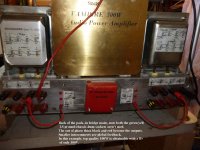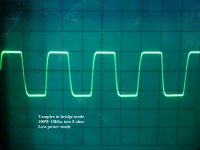Hi!
How is it possible to connect a PP stereo amp to monoblock operation?
For example the BOB CARVER VTA20S “BLACK MAGIC” POWER AMPLIFIER.
Greets:
Tyimo
How is it possible to connect a PP stereo amp to monoblock operation?
For example the BOB CARVER VTA20S “BLACK MAGIC” POWER AMPLIFIER.
Greets:
Tyimo
Although this is perhaps more towards the MI thread; however for a common centre bass LS as some have done, it's better to use a solid state amp.
Both my power amp sections use identical global nfb values i.e one side grounded with two matched amp sections. The spec are identical. Some amps don't like this, as speaker currents with a poor chassis ground can circulate through differing points in the chassis...creating instability.
A+B set at 4ohm outputs; connect 8ohm LS across them.. and one input needs phase reversal; a centre tapped signal transformer or non invert/invert amp option. I have an XLR connector specifically for such work as I use balanced inputs.
I use my Vampire 2 x 250W = 500W for instrumental Tyros 4 keyboard and bass guitar work, but no reason not to use bridged for Hifi.
Some differences; noise figure will be 6dB worse, distortion same, although depends on layout. The caveat with this technique is the load impedance; don't violate it (as one can do with solid state) by using a lower impedance than the equivalent match. This is the surest way of destroying a tube amp output stage.
Some golden rules; one will only get double power ie connect 8 ohm LS to the 2x 4 ohm taps and an incorrect lower impedance will create massive stress to the output stages and power supply too. It pays to have amps with a cathode current monitor, i.e the individual amp currents should be the same bridged with the correct load in case of incorrect setting.
So in the pic, bridged I use two 4 ohm LS cabinets in series = 8 ohms Z, connect amp to each 4 ohms. The speakers are 15" reflex; the port in the base makes use of the flooring and flat down to 28Hz.
Remember, tube amp output stage impedances in bridged config must "see" the correct load impedance for maximum power transfer.
Hope this helps.
richy
Both my power amp sections use identical global nfb values i.e one side grounded with two matched amp sections. The spec are identical. Some amps don't like this, as speaker currents with a poor chassis ground can circulate through differing points in the chassis...creating instability.
A+B set at 4ohm outputs; connect 8ohm LS across them.. and one input needs phase reversal; a centre tapped signal transformer or non invert/invert amp option. I have an XLR connector specifically for such work as I use balanced inputs.
I use my Vampire 2 x 250W = 500W for instrumental Tyros 4 keyboard and bass guitar work, but no reason not to use bridged for Hifi.
Some differences; noise figure will be 6dB worse, distortion same, although depends on layout. The caveat with this technique is the load impedance; don't violate it (as one can do with solid state) by using a lower impedance than the equivalent match. This is the surest way of destroying a tube amp output stage.
Some golden rules; one will only get double power ie connect 8 ohm LS to the 2x 4 ohm taps and an incorrect lower impedance will create massive stress to the output stages and power supply too. It pays to have amps with a cathode current monitor, i.e the individual amp currents should be the same bridged with the correct load in case of incorrect setting.
So in the pic, bridged I use two 4 ohm LS cabinets in series = 8 ohms Z, connect amp to each 4 ohms. The speakers are 15" reflex; the port in the base makes use of the flooring and flat down to 28Hz.
Remember, tube amp output stage impedances in bridged config must "see" the correct load impedance for maximum power transfer.
Hope this helps.
richy
Attachments
If both amps are close in tolerance then the waveforms should be exactly as per pics.
So in this example, total across thick black +red wires = ~30VRMS # 100W. expect no more, unless B+ is hiked up.
So in this example, total across thick black +red wires = ~30VRMS # 100W. expect no more, unless B+ is hiked up.
Attachments
Nobody bridged a stereo PP amp yet????
Look into the Dynaco ST-70 instruction manual. It gives instructions on how it should be done with that amp. It gives a few options according to the speaker setup you want to use.
20
(Thanks 20)...I should have know better and missed that one...Dynaco ST70 uses both outputs paralled with common input signal.
Entirely ones choice which method one wants. As for convenience in studio work, the invert channel in one of the signal paths is the one I use.
r:-
Entirely ones choice which method one wants. As for convenience in studio work, the invert channel in one of the signal paths is the one I use.
r:-
The method of paralleling I/Ps & O/Ps is unreliable. Frequently, heat and bad sound are what is produced.
The method of driving stereoblocks that contain a common ground, including the ST70, with 180o out of phase signals and connecting the speaker across the "hot" terminals IS reliable, but the requirement that 16 Ω speakers be connected to 8 Ω speaker taps and 8 Ω speakers be connected to 4 Ω taps bars the use of 4 Ω speakers (no 2 Ω taps). TANSTAAFL will always be with us.
Bridge a 35 WPC tubed stereoblock and a 70 W. amp is what you get. OTOH, OTL SS stereoblocks that contain bipolar PSUs will (for the 35 WPC example) yield upwards of 100 W. Two factors contribute to the result: each section of the unit gets to draw on approx. 1/2, instead of approx. 1/4, of the PSU and a "constant" voltage source working into a halved impedance produces a doubled power O/P. Real world "sand" amps are far from perfect constant voltage sources, which is why the total bridged power O/P is not doubled.
The method of driving stereoblocks that contain a common ground, including the ST70, with 180o out of phase signals and connecting the speaker across the "hot" terminals IS reliable, but the requirement that 16 Ω speakers be connected to 8 Ω speaker taps and 8 Ω speakers be connected to 4 Ω taps bars the use of 4 Ω speakers (no 2 Ω taps). TANSTAAFL will always be with us.
Bridge a 35 WPC tubed stereoblock and a 70 W. amp is what you get. OTOH, OTL SS stereoblocks that contain bipolar PSUs will (for the 35 WPC example) yield upwards of 100 W. Two factors contribute to the result: each section of the unit gets to draw on approx. 1/2, instead of approx. 1/4, of the PSU and a "constant" voltage source working into a halved impedance produces a doubled power O/P. Real world "sand" amps are far from perfect constant voltage sources, which is why the total bridged power O/P is not doubled.
- Status
- Not open for further replies.
- Home
- Amplifiers
- Tubes / Valves
- Push Pull stereo amp bridged to monoblock operation



